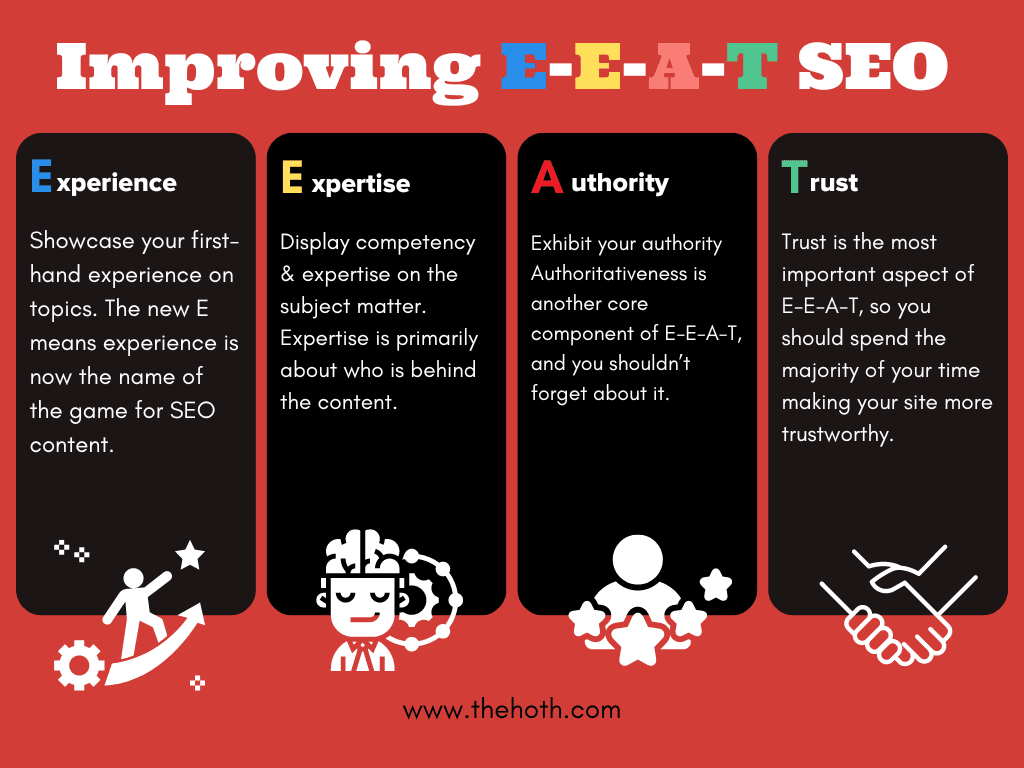
What Makes SEO Writing Unique?
Writing for SEO is unlike any other form of writing, which may throw off some at first. While the mechanics of good writing still apply, such as grammar, spelling, and sentence structure – it also involves clever use of keywords, header tags (H1, H2, H3, etc.), and lots of internal/external linking (with optimized anchor text). Character counts also matter for SEO writing, which is something traditional writers don’t deal with most of the time. For example, title tags that appear on Google’s search results should be no more than 60 characters, which presents a unique writing challenge. Meta descriptions also have a strict character limit of 160, and your H1 tag should be within 60 characters. Why such strict limits? Should you exceed the character limit for a title tag or meta description, it’ll be too long to fully display in Google’s search results, which will look awkward. The use of keywords and character limits exemplifies what makes SEO writing unique. It’s about more than writing coherent sentences and paragraphs. Instead, SEO writing is all about catering to specific search engine factors while still producing excellent content for your readers. Unique challenges of SEO writing include the following:- Placing your target keywords in the right spots in a way that flows naturally and doesn’t appear spammy.
- Fitting your target keywords into title tags, header tags, and meta descriptions that already have strict character limits.
- Presenting your content in an easy-to-read format.
- Uncovering keywords that your audience searches for and then creating content based on them.
How Has SEO Writing Changed?
Besides all the challenges that go along with it, SEO writing is always changing and evolving (just like SEO in general). Writing techniques that worked in the past won’t get you very far today and may even land you a manual penalty from Google. In the early days of search engines, the more times you used your keyword in a post, the higher you would rank on the SERPs. This led to many site owners filling their blogs with keyword-spammy posts that provided little value to readers. As time has gone on, Google has gotten a lot better at cracking down on websites that are trying to ‘game the system’ instead of providing excellent content. Also, the recent update to Google’s Quality Rater Guidelines has changed the way site owners write for SEO. Its famous acronym E-A-T (expertise, authoritativeness, and trustworthiness) gained an extra E that stands for experience. So if you want Google’s quality raters to consider your content high-quality, you need to demonstrate your first-hand experience with a topic (more on this to come). There are also SERP features (image carousels, Knowledge Bar, Local Pack, etc.) that you can target with your SEO writing for an additional boost to your online visibility. If you’re able to rank for a featured snippet, you’ll appear in the coveted position zero (which appears ABOVE the organic search results). All these changes mean that SEO writing looks very different than it did just a year or two ago, so stick to a current guide like this one.10 Tips and Tricks to Perfect SEO Writing
You don’t have to be Ernest Hemingway Jr. to master SEO writing; you just need to understand the type of content your audience wants to see and the search engine optimizations that have the most impact. Once you get the hang of it, you’ll be churning out perfectly-optimized blogs, articles, landing pages, video scripts, and other types of SEO content with ease. Here are 10 of the most critical tips that matter for SEO writing.
#1: Always start by researching keywords
SEO writing wouldn’t exist without keywords, as they’re the terms that your target audience searches for every day. By researching keywords, you’ll be able to discover the types of content that your audience craves. If you attempt to create content without researching keywords first, you’ll either be guessing topics to write about – or you’ll write about what matters most to you. Yet, what matters to you doesn’t necessarily mean that it’ll matter to your audience, which is why you need an informed content strategy backed up by keywords. There are multiple ways to research keywords, but the easiest way is to use a tool like our free keyword planner. By entering a generic keyword related to your niche, our planner tool will provide you with a long list of real-world keywords that your audience searches for the most. These keywords will let you know which type of content you should create to generate the most traffic. For example, say that you’re in the fitness niche and you specialize in meal planning. By entering ‘meal planning’ into our keyword planner, you notice the keyword ‘Mediterranean diet meal plan’ has lots of search volume, a decent KD score, and is trending up in popularity. That means a huge chunk of your core audience is interested in planning meals for the Mediterranean diet – so you should create some content for it – like a blog post entitled ‘How to Master Mediterranean Diet Meal Planning.’Crucial keyword metrics to look for
The most crucial metrics to pay attention to are the following:- Search volume. This number represents how many users are searching for a particular keyword. The higher the search volume for a keyword, the more traffic you stand to generate from it.
- Keyword difficulty (KD) score. A keyword’s difficulty score is a number that represents how hard it will be to outrank competitors on the SERPs for it. If a keyword has a high KD score (anything over 50), it may be wise to consider other keywords.
- Search trend. A keyword’s trend is its popularity over time, which is typically represented in a line graph. If a keyword’s trend is pointing up, that means there’s growing interest in it. If the line is trending down, users are starting to stop searching for it.
- Search intent. Every keyword has an underlying intent, which is what the user wants to find by searching for it. A keyword’s intent can be informational, navigational, commercial, or transactional.
#2: Outline each piece of content
After you have a myriad of topic ideas from your keywords, you can start to outline each piece of content you plan to create. Working from an outline makes SEO writing so much easier, especially blog posts. If we told you to write a 2,000-word blog post without an outline, the task would seem very daunting. Yet, if we provided you with an outline breaking down the post into digestible 200-word chunks, suddenly writing the post doesn’t seem so impossible. Additionally, using an outline will make including any necessary SEO tweaks a lot easier, too. Here’s a quick example of what a typical blog outline looks like:- H1: How to Master Mediterranean Diet Meal Planning
- Introduction - 200 words
- H2: What is the Mediterranean diet? - 200 words
- H3: Health Benefits - 200 words
- H2: Mediterranean Meal Planning Basics - 100 words
- H3: Breakfast - 200 words
- H3: Lunch - 200 words
- H3: Dinner - 200 words
- H2: Conclusion/call-to-action
#3: Use header tags properly
Speaking of header tags, it’s crucial to understand how they work – otherwise, you’ll confuse readers and search engine crawler bots. Your H1 tag serves as the title for the post (only on the web page, not the Google results, as the title tag handles that). For maximum ranking power, your H1 tag needs to contain the target keyword for the post, and it shouldn’t exceed 60 characters. Moreover, do your best to write H1 tags that entice readers to consume your post. A strong H1 tag provides a convenient overview of the topic while also encouraging readers to learn more. H2 tags are the main talking points for the piece, with H3 tags representing subtopics within a talking point. If there are further subtopics to bring up in your H3, then you use an H4, and so on. It’s critical to keep your header tags in order, so never use an H3 tag before an H2 tag, and always ensure that your title is an H1.
#4: Optimize content for humans first, search engines second
This is arguably one of the most important tips for mastering SEO writing, and it’s something that lots of SEOs still need to learn. Above all else, your content exists to provide value to your human audience. While ranking high on search engines is great (and should be your ultimate goal), catering to search engines instead of humans is a losing bet. What do we mean by ‘catering to search engines?’ If you use your target keyword 50x in a 1,000-word blog post in ways that read very awkward and unnatural, you’re optimizing for search engines instead of humans (and you’ll also get flagged for keyword spam in no time). That’s a rather extreme example, but it exemplifies what we’re talking about. All the optimizations you make for search engines, like adding keywords, using inbound links, and targeting SERP features – should all serve to enhance the content you’ve created for your audience, not hinder it. So whenever you’re creating content for your website, do everything that you can to add value to your audience by answering their questions, solving their problems, and providing unique insights that demonstrate your expertise and experience. Do that first, and then pepper in tweaks for search engines, such as injecting keywords in a natural, organic way.#5: Follow E-E-A-T
#6: Target SERP features with your writing
SERP features are a great way to take your online presence to the next level by obtaining position zero. You’ve seen a SERP feature if you’ve ever searched for a simple question on Google and received a response in bold above the organic search results. It looks like this: Alt tag: A screenshot of a Featured Snippet on Google. As you can see, the answer to our question appeared at the very top of the search results, and it includes a link to the website that produced it. This is an extremely powerful position to hold, so you should attempt to target SERP features whenever you can. To find out if your content is eligible for SERP features, you can use Google’s Rich Results Test.#7: Use a combination of inbound and outbound links
Links also play a big role in SEO writing, as it’s a good idea to use both inbound and outbound links in your content. Inbound links are good for your user experience as they create a content loop that will keep your readers engaged on your website. They’re also excellent for SEO, as lots of internal links make it easier for search engine crawlers to make sense of your website’s layout (and to ensure they don’t miss any pages you want them to index). Whenever you create a new piece of content like a blog post, write down all the other web pages that relate to it and then link to them throughout. For instance, if one of your fitness routines comes up when discussing Mediterranean meal planning, why not link to a blog you wrote about it? Outbound links are great because they help boost your website’s authority (as long as you link to trusted, reputable websites).#8: Add keywords to metadata
Title tags are HTML tags that serve as the title for your content on Google’s SERPs, and you should include your target keyword in them. Additionally, including your keyword in your meta description is also a good idea, but it’s not entirely necessary. Your meta description serves to entice readers to click on your link, so include a call-to-action (CTA).#9: Use keyword-rich alt text for images
Any images that you include in your post need to contain alt text. What’s that? It’s a brief line of text that describes the content of an image, and it serves two purposes. First, it helps seeing-impaired readers to understand your images. Second, it’s the way that search engine crawler bots understand how your images relate to your content (since they lack computer vision). When writing alt-text, always include the target keyword for each post.#10: Editing and proofreading
Lastly, every piece of content you write needs to go through the editing and proofreading process. First drafts are always rough, even if you’re an experienced writer. Tools like Grammarly are excellent for proofreading, but you can’t replace a human editor reviewing each piece – so use both. Things to look for during editing and proofreading include:- Short sentences and paragraphs for optimal readability
- Proper use of keywords
- Internal and external links that aren’t broken
- Spelling and grammatical errors

Final Takeaways: Perfecting SEO Writing
These 10 steps will help you produce outstanding SEO content that caters to both search engines and your audience. With excellent SEO writing, you’ll be able to dominate the SERPs, gain a loyal following, and grow your business. Do you not have time to write stellar SEO content yourself? Then you need to check out HOTH X, our managed SEO services, and HOTH Blogger, our five-star content writing service.The author
Rachel Hernandez
description
Previous
Relationship-Based Link-Building: The New Way to Build Links
Next
Google’s August 2023 Core Update: What SEOs Need to Know
Discussion
Comments
Codei5 Academy
December 4th, 2024
Great insights on mastering SEO writing! We completely agree that combining strong writing with SEO best practices is key to achieving high rankings on Google. The tips you’ve shared, especially the importance of keyword research and targeting SERP features, are spot on. At Codei5 Academy, we emphasize these strategies in our SEO training to help students excel in digital marketing. Keep up the fantastic work!
Joquim
July 11th, 2024
I must say, the topic of SEO writing is more crucial than ever, especially with the ever-evolving algorithms and increasing competition in the digital landscape. The constant updates in search engine algorithms and user behavior keep writers on their toes, making it an exciting yet challenging field to master.
Wolfgang
September 4th, 2023
Dear Rachel,
thank you for this very helpful article about SEO. I am going to use your tips for keyword research. 🙂Kind regards.
Wolfgang


